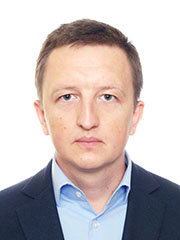About the article
DOI: https://www.doi.org/10.15219/em92.1539
The article is in the printed version on pages 36-44.
 Download the article in PDF version
Download the article in PDF version
How to cite
Horbliuk, S., & Stepanets, I. (2021). Public policy on city center revitalization based on the Town Centre Management concept. e-mentor, 5(92), 36-44. https://doi.org/10.15219/em92.1539
E-mentor number 5 (92) / 2021
Table of contents
About the authors
Public policy on city center revitalization based on the Town Centre Management concept
Serhii Horbliuk, Inna Stepanets
Abstract
Nowadays, it is impossible to ensure sustainable development of the state without using innovative policies of territorial development, one of which is a city revitalization policy. This article defines the main causes of city center degradation and typical approaches to revitalizing city centers in Europe and North America. The New Urbanism principles are outlined as regards city center revitalization, with an emphasis on their potential importance for sustainable urban development. The evolution of Town Centre Management (TCM) and the features of its application are characterized by authors with a focus on the mechanisms of anti-crisis management professionalization in the conditions of degrading city centers.
A model of the public policy on city center revitalization based on the TCM concept is presented, which envisages the functioning of a TCM manager (office) of (with a list of the main tasks); objectives and the sequence of policy implementation stages; application of tools for public participation and a public-private partnership in this process; city center revival through an integrated effect on various spheres (community, economy, space and environment), and, as a result, achievement of a multiplicative effect for the promotion and development of the entire city. The study used a set of general scientific and specialized methods that are based on the modern scientific principles of public administration and its related sciences (geography, economics, sociology, culturology, etc.), and interdisciplinary and systematic approaches.
Keywords: city center revitalization, Town Centre Management (TCM), New Urbanism, suburbanization, sustainable development
References
- Anttiroiko, A. V., & de Jong, M. (2020). The inclusive city: The theory and practice of creating shared urban prosperity. Springer International Publishing.
- Berg, L., van den, Drewett, R., Klaasen, L. H., Rossi, A., & Vijverberg, C. H. (1982). Urban Europe: A study of growth and decline. Pergamon.
- Bernaciak, A. (2015). Współczesne przemiany centrów miast w świetle wybranych doświadczeń amerykańskich i europejskich. Ruch Prawniczy, Ekonomiczny i Socjologiczny, 77(4), 265-275. https://doi.org/10.14746/rpeis.2015.77.4.20
- Boryczka, E. M. (2013). Town Centre Management - koncepcja zarządzania centrum miasta na przykładzie miast europejskich. Zeszyty Naukowe Politechniki Częstochowskiej. Zarządzanie, 12, 119-130. http://www.sbc.org.pl/Content/359890/boryczka.pdf
- Council of Europe. (2008). European Urban Charter II: Manifesto for a new urbanity. https://rm.coe.int/european-urban-charter-ii-manifesto-for-a-new-urbanity/168071a1b5
- De Magalhães, C., Healey, P., & Madanipour, A. (2017). Assessing institutional capacity for city centre regeneration: Newcastle's Grainger Town. In G. Cars, P. Healey, A. Madanipour, & C. De Magalhães (Eds.), Urban governance, institutional capacity and social milieux (pp. 45-62). Routledge. https://doi.org/10.4324/9781315202877-4
- Duany, A., & Plater-Zyberk, E. (1994). The neighborhood, the district and the corridor. In P. Katz (Ed.), The New Urbanism: Toward an architecture of community (pp. 17-20). McGraw-Hill.
- Falanga, R. (2020). Formulating the success of citizen participation in urban regeneration: Insights and perplexities from Lisbon. Urban Research & Practice, 13(5), 477-499. https://doi.org/10.1080/17535069.2019.1607895
- Fulton, W. (1996). The New Urbanism. Hope or hype for American communities? Lincoln Institute of Land Policy.
- Gawłowski, R. (2018). Town Centre Management jako narzędzie zarządzania procesem rewitalizacji. Ekspertyzy i opracowania, 64, 1-9. https://www.nist.gov.pl/files/zalacznik/1547044268_EKSPERTYZA%2064.pdf
- Gehl, J. (2010). Cities for people. Island Press.
- Gu, C. (2019). Urbanization: Processes and driving forces. Science China Earth Sciences, 62(9), 1351-1360. https://doi.org/10.1007/s11430-018-9359-y
- Horbliuk, S., & Dehtiarova, I. (2021). Approaches to urban revitalization policy in light of the latest concepts of sustainable urban development. Baltic Journal of Economic Studies, 7(3), 46-55. https://doi.org/10.30525/2256-0742/2021-7-3-46-55
- Jakóbczyk-Gryszkiewicz, J. (2008). Procesy urbanizacji. In S. Liszewski (Ed.), Geografia urbanistyczna (p. 155-186). Wydawnictwo Uniwersytetu Łódzkiego.
- Jang, H. J., & Jung, T. (2015). Go slow and curvy: Understanding the philosophy of the Cittaslow slowcity phenomenon. Springer International Publishing.
- Jarczewski, W., Dawid, W., Janik, A., Jadach-Sepioło, A., Janas, K., Koj, J., Kudłacz, K., Mróz, M., Dobosz-Mucha, A., Muzioł-Węcławowicz, A., Nowak, K., Piech, K., Sroka, B., Sykała, Ł., & Ziółkowska, M. (2019). Rewitalizacja. Instytut Rozwoju Miast i Regionów.
- Kamiński, J. (2006). TCM - zarządzanie centrum miasta. Biuletyn ZPORR, 5, 8-9.
- Landry, C. (2012). The creative city: A toolkit for urban innovators (2nd ed). Earthscan.
- Leary, M. E., & McCarthy, J. (Eds.). (2013). The Routledge companion to urban regeneration. Routledge.
- Majer, A. (1999). Miasta Ameryki: kryzys i polityka odnowy. Wydawnictwo Naukowe PWN.
- Montgomery, C. (2013). Happy city: Transforming our lives through urban design. Farrar, Straus and Giroux.
- Olbińska, K. (2020). Planowanie procesów rewitalizacji miast. Teoria i praktyka. Wydawnictwo Uniwersytetu Łódzkiego.
- Roberts, P., Sykes, H., & Granger, R. (Eds.). (2016). Urban regeneration. Sage.
- Tallon, A. (2020). Urban regeneration in the UK. Routledge.
- United Nations. (2015). Transforming our world: the 2030 Agenda for Sustainable Development. https://sdgs.un.org/2030agenda
- United Nations. (2016). New Urban Agenda. https://uploads.habitat3.org/hb3/NUA-English.pdf
- Whyatt, G. (2004). Town centre management: how theory informs a strategic approach. International Journal of Retail & Distribution Management, 32(7), 346-353. https://doi.org/10.1108/09590550410541462
- Wojnarowska, A. (2017). Rewitalizacja a jakość przestrzeni publicznej centrum miasta. MAZOWSZE Studia Regionalne, 21, 35-52. https://doi.org/10.21858/msr.21.03


 http://orcid.org/0000-0002-5031-2497
http://orcid.org/0000-0002-5031-2497